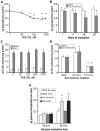PCB 126 and other dioxin-like PCBs specifically suppress hepatic PEPCK expression via the aryl hydrocarbon receptor
- PMID: 22615911
- PMCID: PMC3353882
- DOI: 10.1371/journal.pone.0037103
PCB 126 and other dioxin-like PCBs specifically suppress hepatic PEPCK expression via the aryl hydrocarbon receptor
Abstract
Dioxins and dioxin-like compounds encompass a group of structurally related heterocyclic compounds that bind to and activate the aryl hydrocarbon receptor (AhR). The prototypical dioxin is 2,3,7,8-tetrachlorodibenzo-p-dioxin (TCDD), a highly toxic industrial byproduct that incites numerous adverse physiological effects. Global commercial production of the structurally similar polychlorinated biphenyls (PCBs), however, commenced early in the 20(th) century and continued for decades; dioxin-like PCBs therefore contribute significantly to total dioxin-associated toxicity. In this study, PCB 126, the most potent dioxin-like PCB, was evaluated with respect to its direct effects on hepatic glucose metabolism using primary mouse hepatocytes. Overnight treatment with PCB 126 reduced hepatic glycogen stores in a dose-dependent manner. Additionally, PCB 126 suppressed forskolin-stimulated gluconeogenesis from lactate. These effects were independent of acute toxicity, as PCB 126 did not increase lactate dehydrogenase release nor affect lipid metabolism or total intracellular ATP. Interestingly, provision of cells with glycerol instead of lactate as the carbon source completely restored hepatic glucose production, indicating specific impairment in the distal arm of gluconeogenesis. In concordance with this finding, PCB 126 blunted the forskolin-stimulated increase in phosphoenolpyruvate carboxykinase (PEPCK) mRNA levels without affecting glucose-6-phosphatase expression. Myricetin, a putative competitive AhR antagonist, reversed the suppression of PEPCK induction by PCB 126. Furthermore, other dioxin-like PCBs demonstrated similar effects on PEPCK expression in parallel with their ability to activate AhR. It therefore appears that AhR activation mediates the suppression of PEPCK expression by dioxin-like PCBs, suggesting a role for these pollutants as disruptors of energy metabolism.
Conflict of interest statement
Figures







Similar articles
-
Toxicology and carcinogenesis studies of a binary mixture of 3,3',4,4',5-pentachlorobiphenyl (PCB 126) (Cas No. 57465-28-8) and 2,3',4,4',5-pentachlorobiphenyl (PCB 118) (Cas No. 31508-00-6) in female Harlan Sprague-Dawley rats (gavage studies).Natl Toxicol Program Tech Rep Ser. 2006 Nov;(531):1-218. Natl Toxicol Program Tech Rep Ser. 2006. PMID: 17342196
-
NTP toxicology and carcinogenesis studies of 3,3',4,4',5-pentachlorobiphenyl (PCB 126) (CAS No. 57465-28-8) in female Harlan Sprague-Dawley rats (Gavage Studies).Natl Toxicol Program Tech Rep Ser. 2006 Jan;(520):4-246. Natl Toxicol Program Tech Rep Ser. 2006. PMID: 16628245
-
Toxicology and carcinogenesis studies of a mixture of 2,3,7,8-tetrachlorodibenzo-p-dioxin (TCDD) (Cas No. 1746-01-6), 2,3,4,7,8-pentachlorodibenzofuran (PeCDF) (Cas No. 57117-31-4), and 3,3',4,4',5-pentachlorobiphenyl (PCB 126) (Cas No. 57465-28-8) in female Harlan Sprague-Dawley rats (gavage studies).Natl Toxicol Program Tech Rep Ser. 2006 Sep;(526):1-180. Natl Toxicol Program Tech Rep Ser. 2006. PMID: 17342195
-
Dioxin-like and non-dioxin-like toxic effects of polychlorinated biphenyls (PCBs): implications for risk assessment.Crit Rev Toxicol. 1998 Nov;28(6):511-69. doi: 10.1080/10408449891344263. Crit Rev Toxicol. 1998. PMID: 9861526 Review.
-
Developmental dental toxicity of dioxin and related compounds--a review.Int Dent J. 2006 Dec;56(6):323-31. doi: 10.1111/j.1875-595x.2006.tb00336.x. Int Dent J. 2006. PMID: 17243464 Review.
Cited by
-
PCB126 Inhibits the Activation of AMPK-CREB Signal Transduction Required for Energy Sensing in Liver.Toxicol Sci. 2018 Jun 1;163(2):440-453. doi: 10.1093/toxsci/kfy041. Toxicol Sci. 2018. PMID: 29474705 Free PMC article.
-
Overexpression of Nudt7 decreases bile acid levels and peroxisomal fatty acid oxidation in the liver.J Lipid Res. 2019 May;60(5):1005-1019. doi: 10.1194/jlr.M092676. Epub 2019 Mar 7. J Lipid Res. 2019. PMID: 30846528 Free PMC article.
-
Laparoscopic Sleeve Gastrectomy in Patients with Severe Obesity Restores Adaptive Responses Leading to Nonalcoholic Steatohepatitis.Int J Mol Sci. 2022 Jul 15;23(14):7830. doi: 10.3390/ijms23147830. Int J Mol Sci. 2022. PMID: 35887177 Free PMC article.
-
Refeeding-induced brown adipose tissue glycogen hyper-accumulation in mice is mediated by insulin and catecholamines.PLoS One. 2013 Jul 4;8(7):e67807. doi: 10.1371/journal.pone.0067807. Print 2013. PLoS One. 2013. PMID: 23861810 Free PMC article.
-
The hijacking of cellular signaling and the diabetes epidemic: mechanisms of environmental disruption of insulin action and glucose homeostasis.Diabetes Metab J. 2014 Feb;38(1):13-24. doi: 10.4093/dmj.2014.38.1.13. Diabetes Metab J. 2014. PMID: 24627823 Free PMC article. Review.
References
-
- WHO . Geneva, Switzerland: World Health Organization; 2003. Polychlorinated biphenyls: human health aspects. pp. 1–64.
-
- Turrio-Baldassarri L, Abate V, Alivernini S, Battistelli CL, Carasi S, et al. A study on PCB, PCDD/PCDF industrial contamination in a mixed urban-agricultural area significantly affecting the food chain and the human exposure. Part I: soil and feed. Chemosphere. 2007;67:1822–1830. - PubMed
-
- Ward MP, Jablonski C, Semel B, Soucek D. The biological pathway and effect of PCBs on common terns in Lake Michigan. Ecotoxicology. 2010;19:1513–1522. - PubMed
-
- Perez-Fuentetaja A, Lupton S, Clapsadl M, Samara F, Gatto L, et al. PCB and PBDE levels in wild common carp (Cyprinus carpio) from eastern Lake Erie. Chemosphere. 2010;81:541–547. - PubMed
-
- Patterson DG, Turner WE, Caudill SP, Needham LL. Total TEQ reference range (PCDDs, PCDFs, cPCBs, mono-PCBs) for the US population 2001–2002. Chemosphere. 2008;73:S261–S277. - PubMed
Publication types
MeSH terms
Substances
Grants and funding
LinkOut - more resources
Full Text Sources
Other Literature Sources

